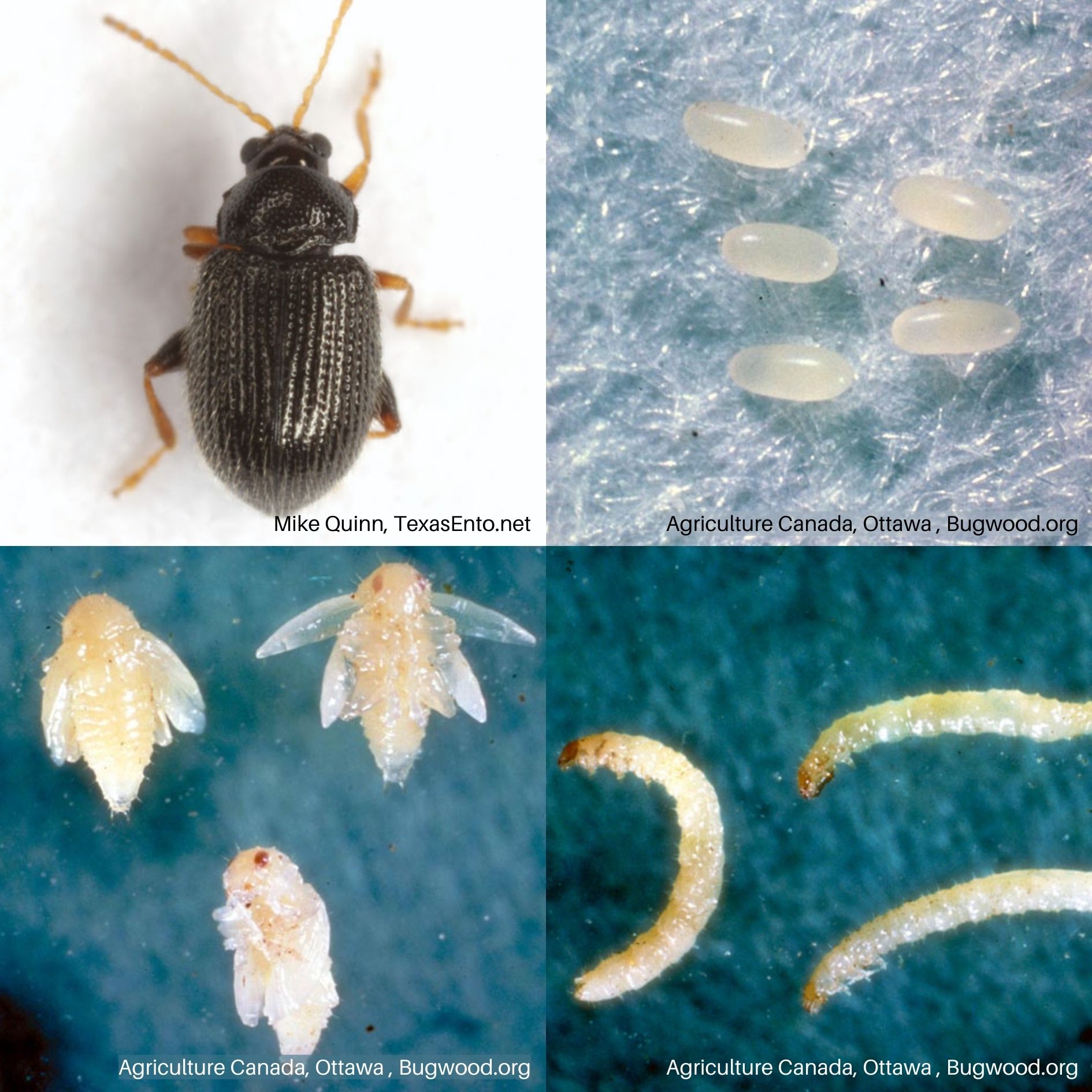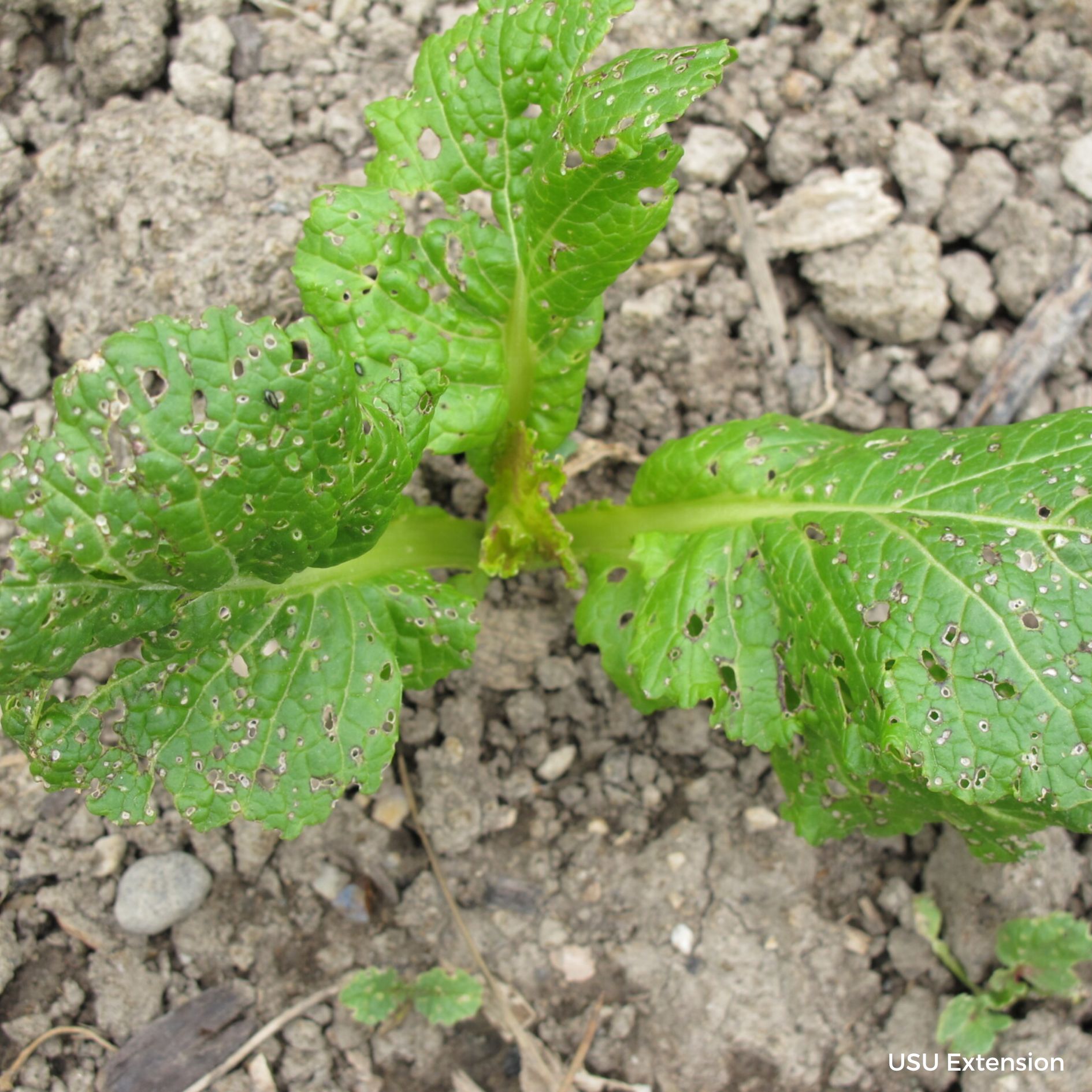Flea Beetles
 Tuber Flea Beetle (Epitrix tuberis) Life Stages
Tuber Flea Beetle (Epitrix tuberis) Life Stages Flea Beetle Species in Utah
Flea Beetle Species in Utah Flea Beetle Damage on a Kohlrabi
Flea Beetle Damage on a Kohlrabi Feeding Damage on Foliage
Feeding Damage on FoliageHOSTS
- Brassicas
- Leafy Greens
- Solanaceae Crops
- Root Crops
- Cucurbits
- Potato
OVERVIEW
Flea beetles are common and problematic in Utah. They are present in late spring and early summer on many vegetable crops and ornamental plants. Adult flea beetles are small, shiny insects that have enlarged hind legs, allowing them to jump great distances when disturbed. They are strong fliers, moving into crops from neighboring fields and weedy borders.
DESCRIPTION
Eggs are elliptical and half a millimeter long. Larvae are worm like with a white body and brown head. Adults typically range from 1/15 to 1/6 inch (1.7 to 4.2 mm) long. They have large hind legs for jumping. Various species range in color from brown, green, metallic-blue to black; may have stripes or spots.
BIOLOGY
Egg | Larva | Pupa | Adult
Most flea beetle species overwinter as adults in protected places such as under leaf litter, dirt clods, or on weeds along field borders and ditch banks. Adults become active in mid-to late spring and feed on weeds and other available plants. When their preferred host plants become available, and/or when weeds dry up, the adult flea beetle will move to nearby fields or vegetable gardens.
After several weeks of feeding, adults of most species of flea beetles begin laying eggs in the soil at the base of desirable host plants. Minute, worm-like larvae hatch and begin feeding on small roots and root hairs. For a few species of flea beetles that develop above ground, eggs are laid in masses on leaves or twigs and young larvae feed on leaves producing skeletonizing injury similar to other leaf beetles. The larval stage typically lasts about a month; then they pupate and emerge as the second generation of adults in late spring to mid-summer. A third generation may occur for some flea beetle species.
SYMPTOMS
- Small, round holes or pits in leaves and cotyledons.
SYMPTOMS
- Scout for flea beetle damage, especially near field edges, starting as soon as seedlings emerge.
- Use yellow sticky traps to monitor flea beetle populations.
GENERAL MANAGEMENT
The high mobility of flea beetles can make management more challenging. Understanding their biology and life cycle will help identify effective strategies and optimal timings to reduce their negative impacts. When management of flea beetles is warranted, a combination of cultural, physical, biological, and chemical options should be used.
- Adjust planting times to avoid peak flea beetle activity.
- Promote healthy, fast-growing plants to minimize their vulnerability to flea beetles.
- Plant trap crops that are highly attractive to flea beetles.
- Companion plants can confuse, repel, or block insect pests from finding host plants.
- Remove old plant residue and nearby weeds as those can serve as alternate hosts.
- Row covers are used to cover plants to create a physical barrier against pest insects.
- Generalist predators such as larvae of lacewing, adult big-eyed bugs and damsel bugs feed on adult flea beetles.
INSECTICIDES
Although foliar application of insecticides is the most common management tactic for flea beetles, insecticides should only be used if necessary. Since plants produce continuous new growth and the highly mobile beetles can rapidly reinvade plantings, insecticides may have to be applied more than once to cover the plant’s susceptible period.

